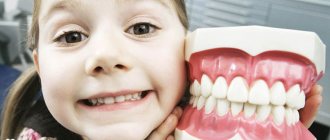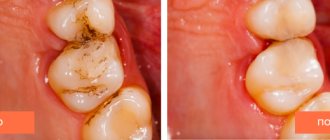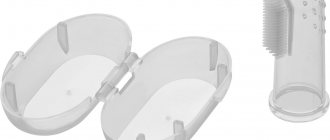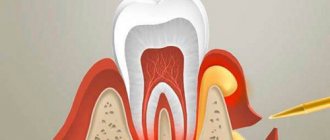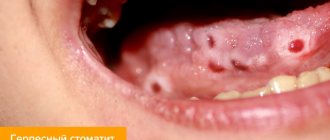Treatment of gums in children is a common reason for visiting a dentist. The susceptibility of delicate gums to inflammatory processes is explained by their sensitivity to all kinds of damage and poor hygiene. The remaining soft plaque on the teeth eventually turns into hard deposits in the form of tartar. Inflammation can also be caused by an infection that enters the oral cavity through dirty toys, for example. Unfortunately, parents are not always able to monitor the regularity and quality of brushing their children’s teeth or protect them from licking dirty surfaces.
Inflammation of the mucous membrane of the gums or gingivitis must be detected as early as possible and treatment begun. This is why regular scheduled examinations are so important. A delay in making a visit can result in a complication - there is a risk of transition to a chronic form, after which - to the ulcerative-necrotic stage, and, as a result, damage to surrounding tissues. Periodontitis is one of the most serious stages of gum disease.
Teething in infants is not only a painful process, but also provokes inflammation of the gums, as well as injuries, as a result of diligently sucking a rattle or a cracker offered by the mother...
Causes of gum inflammation in children
- Skipping or poor quality teeth brushing;
- Sucking dirty objects;
- Errors when installing seals;
- Pathologies of the dentition;
- Carious cavities with sharp edges;
- Bite correction;
- Breathing through the mouth;
- Abnormal structure of the oral cavity organs (attachment of the frenulum of the tongue and lips);
- Problems with the functioning of the cardiovascular system;
- Disruption of the gastrointestinal tract;
- Infectious diseases (ARVI, influenza);
- Hormonal abnormalities;
- Hereditary anomalies.
How to treat gingivitis in children
Gingivitis is a disease with a favorable prognosis. Accurate adherence to the doctor’s recommendations makes it possible to fully recover and eliminate future relapses.
Treatment always begins with sanitation of the oral cavity. Removing tartar and soft plaque is mandatory, since deposits are a source of infection. For young children, cleansing is carried out using special brushes, for older children (after 10 years) - using ultrasound. After cleansing, the doctor prescribes rinsing with anti-inflammatory agents twice a day (in pharmaceutical form or decoctions of chamomile, sage, mint, eucalyptus).
Important. Dear parents. It is not possible to cure the disease with folk remedies alone. By neglecting this rule, you risk aggravating your child's condition.
When treating gingivitis, the doctor uses an integrated approach, taking into account the individual characteristics of the child. Carious cavities are removed, and fillings with overhanging edges or poor polishing are replaced. If there is a congenital malocclusion or tongue frenulum, the necessary manipulations are performed. At a certain stage, consultations with narrow specialists may be required - a dental surgeon, an orthopedic dentist, a therapist, an endocrinologist, a cardiologist.
If necessary, the doctor prescribes intraoral electrophoresis, laser therapy, massage, and ultraviolet radiation. At an advanced stage of the disease, antibiotics are necessary. In severe cases, when conservative therapy is unsuccessful, surgery may be required.
The most important role in the treatment of gingivitis in children is played by vitamin therapy and proper nutrition. It is necessary to create a diet in such a way that you use foods high in vitamins for cooking.
Important. During treatment, you need to ensure that the food is ground or soft. Parents are required to ensure that the eating process causes as little discomfort as possible.
Types of inflammatory processes
Gingivitis
Inflammation of the gums at the initial stage, that is, not yet spreading to the bone tissue, is called gingivitis.
Treatment of gingivitis in children follows the same principle as in adults, with the only difference being that children are prescribed more gentle medications. When starting the procedure, the hygienist performs professional cleaning, removing plaque and stone, after which he teaches the little patient proper hygiene techniques. Helps you navigate the selection of toothpaste and brush.
Periodontitis
Inflammation of the gums and periodontal tissues - periodontitis - is an advanced stage of gum disease. If left untreated, its progression may result in one or more teeth having to be removed.
Treatment includes occupational hygiene and physical therapy. If the process is advanced, surgical intervention may be required.
Periodontal disease in children
The defeat of all periodontal tissues, in this case, is called childhood periodontal disease. This degree is quite rare. Progression can be triggered by weakened immunity and vitamin deficiency.
An effective option in this case is surgical intervention, as well as strengthening the general condition of the body.
Stomatitis in children
Infectious inflammation of the mucous membrane of the gums, or stomatitis, is characterized by increased sensitivity and discomfort while eating. Therefore, you should show it to a dentist as soon as possible. A dental clinic specialist will examine the baby and prescribe appropriate procedures.
Causes of gingivitis in children
80-90% of cases of the disease in children are associated with the accumulation of dental plaque, which is an ideal environment for the proliferation of pathogenic microflora. The more dental plaque there is and the older it is, the greater the number of bacteria that develop in it. One day without oral hygiene is enough for the first signs of the disease to appear. Treatment of gingivitis in this case comes down to professional hygiene - removing stones and plaque.
Predisposing factors also include uneven load on the child’s periodontal complex. This may be due to an incorrect bite, crowded teeth, tooth decay or poorly fitting fillings. The appearance of gingivitis in children can be caused by injury to the gums (for example, while brushing teeth), or as a result of burns from hot food.
In some patients, acute gingivitis occurs against the background of teething or changing teeth. The gums become inflamed at this time, acquiring a characteristic bright red color. Puberty is also a risk factor.
In some cases, gingivitis can develop against the background of past infections or systemic diseases that weaken the immune system. Diabetes mellitus, heart disease and thyroid disease predispose to the onset of the disease.
Gum atrophy
A rather unique and rare disease - gum atrophy or exposing atrophic gingivitis manifests itself as itching in the area of 2, less often 4 and 6 symmetrically located milk teeth. A child experiencing discomfort constantly rubs the area of inflammation. At night, the itching usually intensifies.
The interdental papillae and other areas of the gums do not change in any way during gingival atrophy. Slight deposits of tartar are often observed on the unprotected root surface.
The manifestation of itching can be a consequence of measles or influenza, despite the fact that in most young patients such a relationship is not observed. The process of teething is also one of the factors causing itching in infants.
Why do gums become inflamed?
The main cause of inflammation is the same in both adults and children - poor oral hygiene, that is, insufficient quality of teeth cleaning. In children, additional factors also play a significant role:
- In the youngest children, gingivitis occurs during teething;
- the cause may be malocclusion in children, causing uneven distribution of the chewing load;
- gums become inflamed due to a lack of vitamins and minerals in the child’s body;
- inflammation is provoked by advanced caries and its unprofessional treatment - in particular, incorrectly installed fillings that constantly injure the mucous membrane;
- the presence of chronic diseases also affects;
- Children with weakened immune systems suffer from gingivitis.
Conventionally, gingivitis that occurs during the eruption of primary or permanent teeth and the formation of dental roots can be called a physiological norm. In all other cases, professional diagnosis and consultation with other medical specialists are necessary to help identify the cause of gum inflammation in children and carry out effective treatment.
Diagnosis of gum disease in children
A routine oral examination should be performed by a pediatric dentist every six months. And as necessary, if a small patient exhibits any deviations in the development of teeth or symptoms of disease of the oral mucosa. Since it is advisable to diagnose the inflammatory process at the earliest stage.
If redness, swelling and bleeding are detected, the cause of which is an excessive amount of soft plaque or food debris on the teeth, the dentist will make a diagnosis and prescribe procedures.
If a bacterial infection is suspected, a clinic specialist can take biomaterial from the inflamed areas of the gums for clinical tests. Based on the results of the analysis, the specialist prescribes a treatment plan and the date of the next appointment to ensure the final recovery of the little patient.
Preventive work to prevent disease
To prevent unwanted consequences, parents should not only regularly monitor their child’s oral hygiene, but also visit the pediatric dentist’s office once every six months. For dental care, it is recommended to choose only high-quality toothpastes that have a pleasant taste for children and brushes with soft bristles. If your child already knows how to rinse his mouth, you can also use ready-made mouthwash solutions or those prepared at home (infusions of sage, chamomile, calendula) to maintain hygiene.
The child’s diet is of great importance, which should contain as many healthy foods, fruits and vegetables as possible. To strengthen gums and immunity in general, it is recommended to consume vitamins and take regular walks in the fresh air.
A timely visit to the dentist will not only identify the diseases that triggered the appearance of gum inflammation in children, but also prevent the inflammation itself, and if diagnosed at an early stage, get rid of the disease quickly and easily!
Treatment of gums in children
Medicines prescribed by a doctor have analgesic, antibacterial and anti-inflammatory effects. They help restore the proper condition of the mucous membrane. Methods of using drugs are different, but the principle is the same: rinsing, irrigation.
For gum disease in infants, the dentist will prescribe special gels to relieve symptoms, namely itching and pain. Parents should pay special attention to cleaning their mouths from food debris.
Antibiotics are prescribed by a dentist in rare cases. Indications for the use of antibiotics is a form that reaches a complex (ulcerative-necrotizing gingivitis) or chronic stage. Antibacterial or antifungal drugs are prescribed when the problem is caused by an infectious process, and the goal is to eliminate its causative agent.
Symptoms of gingivitis in children
Common symptoms of gingivitis in children include swelling of the gums, congestion (fullness of the blood vessels with blood), and pain in the mouth. In the advanced form, fever and general malaise are associated. Also a common feature for all varieties is poor oral hygiene.
Quite often, stomatitis (gingivostomatitis) is associated with gingivitis. In this case, not only the gums suffer, but also the entire oral mucosa. The child experiences constant pain, itching, burning, and becomes capricious and uncontrollable.
Viral gingivitis is especially dangerous against the background of a herpes infection, quickly turning into an ulcerative form. Young children are most susceptible to it. A one-year-old child, due to his age, pulls all objects into his mouth, thereby creating a favorable environment for the development of pathogenic bacteria.
Preventive actions
The best prevention of inflammation of the mucous membrane is daily and high-quality hygiene from an early age and proper nutrition.
Hygiene
The concept of “quality hygiene” includes brushing your teeth at least twice: in the morning and in the evening, in conjunction with cleaning the palate and tongue.
Parents should take a very responsible approach to hygiene from the day the first tooth appears. And after he grows up a little, learn the rules of brushing his teeth: regularly and efficiently. The toothbrush and toothpaste should be selected according to the age of the small patient.
Nutrition
In addition to hygiene, parents need to approach the diet wisely: it should be balanced and include vitamins and minerals. Sweets and carbonated drinks should be consumed by the child in limited quantities. In addition, after finishing eating sweets, the baby should rinse his mouth with water and, if possible, brush his teeth. Note that a diet that promotes the proper development of a growing body includes nutritious and timely meals. Snacking and disordered eating should be kept to a minimum.
Treatment of children at RAIDEN
In the RAIDEN network of dental clinics, the treatment and prevention of oral diseases of young patients is treated with the utmost attention and reverence - the health of the younger generation is very important to us!
All medications used in our clinic meet the highest quality requirements. Before using them, we conduct a blood test of the baby to determine drug tolerance. The safety of your children, our little patients, is paramount to us.
